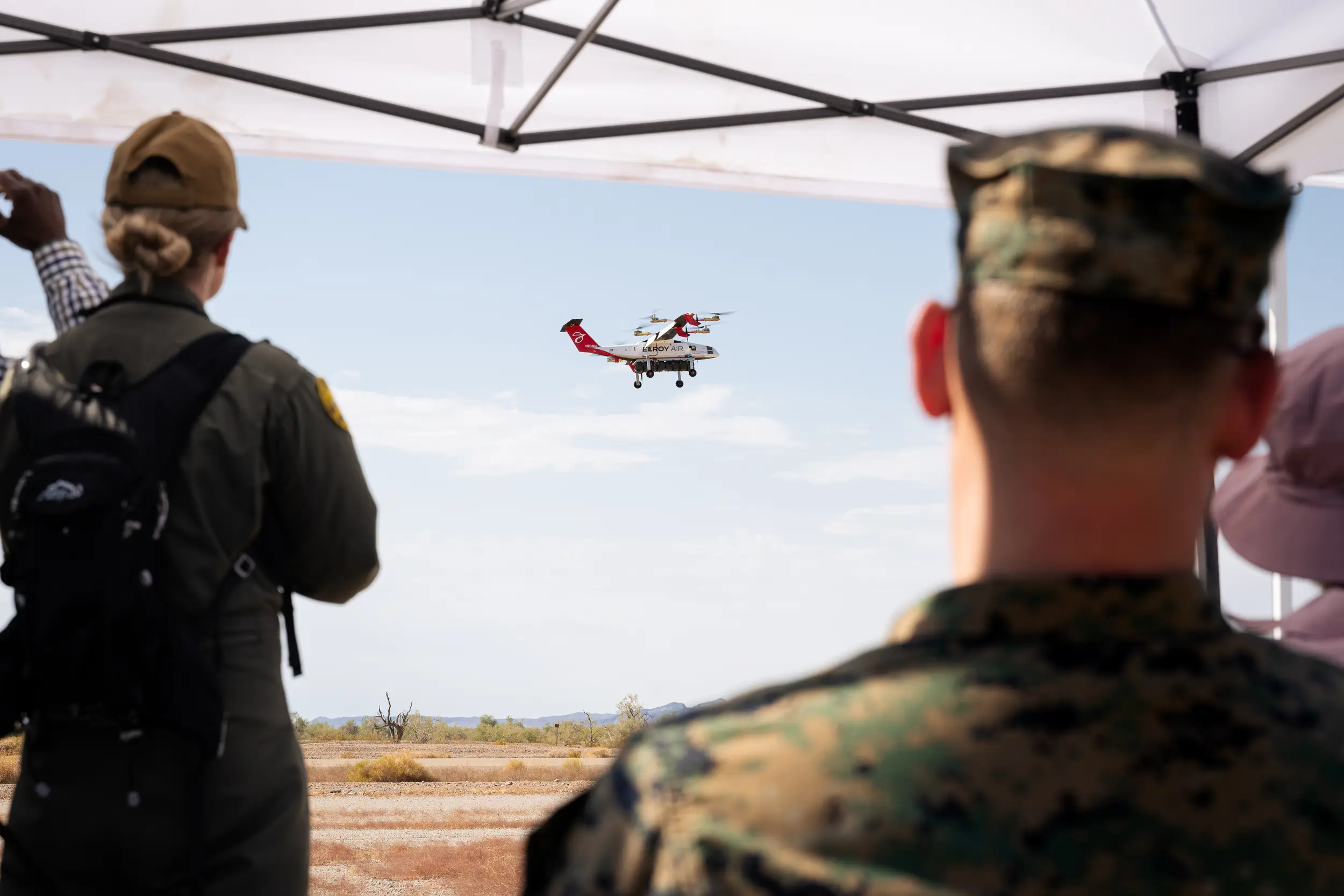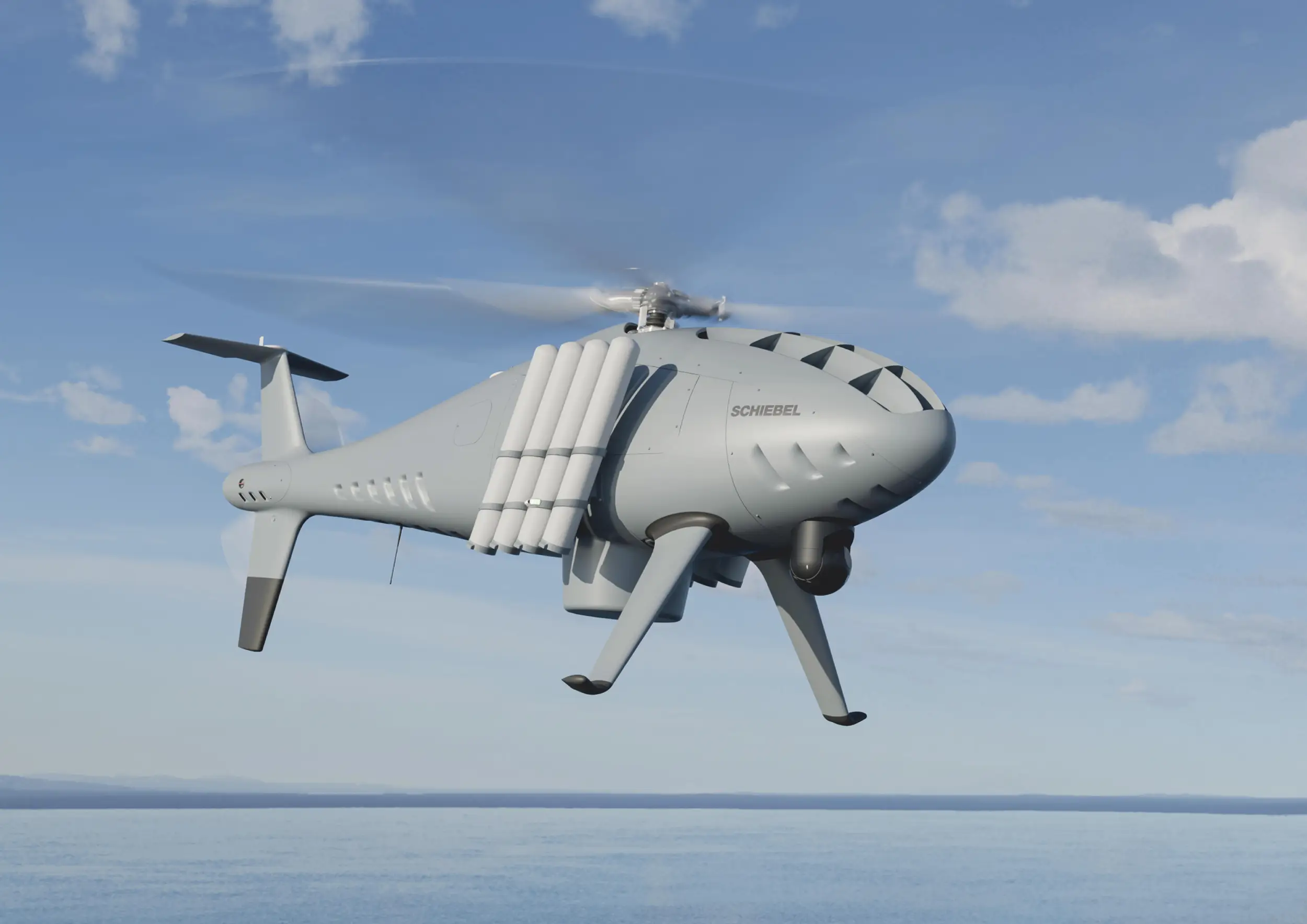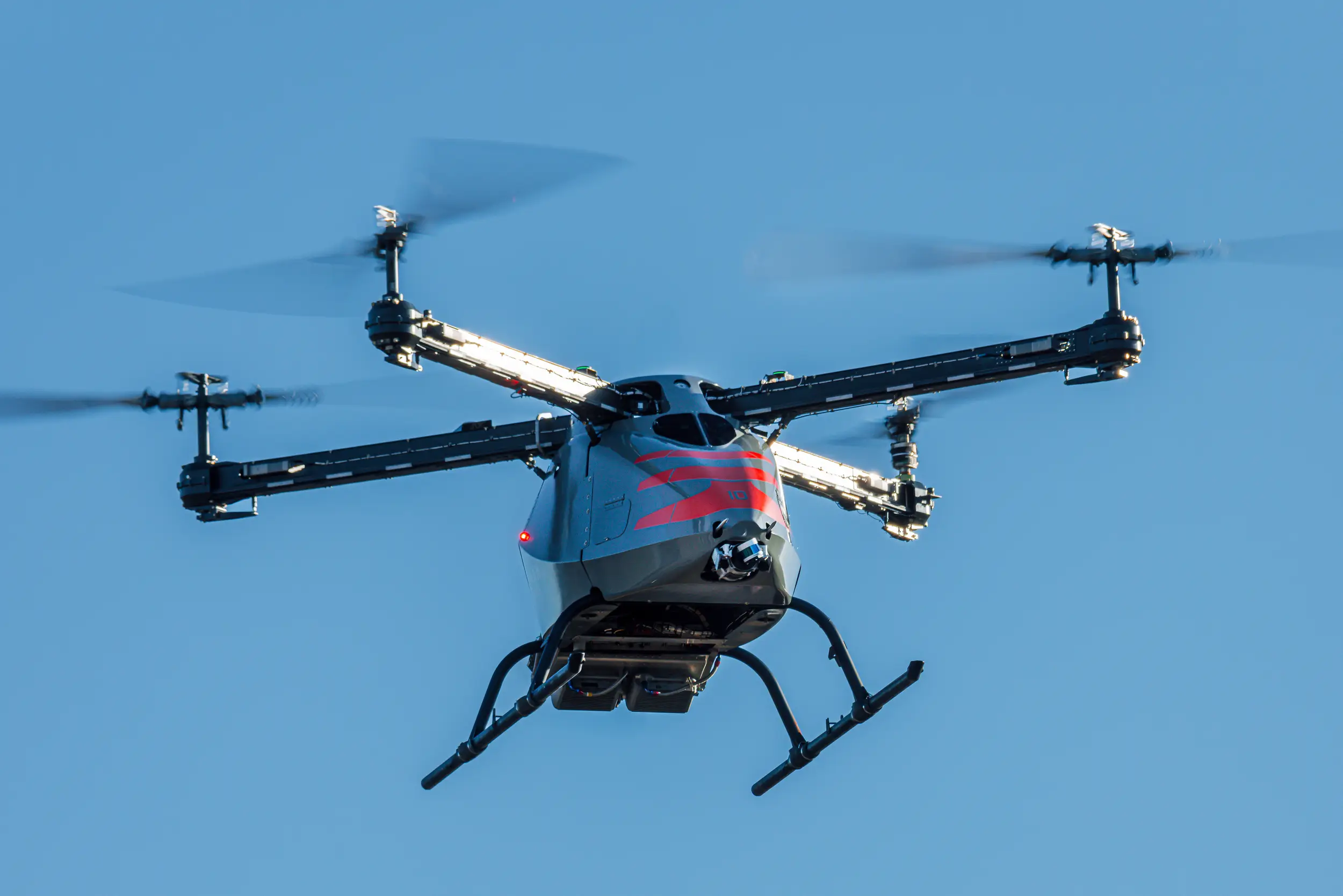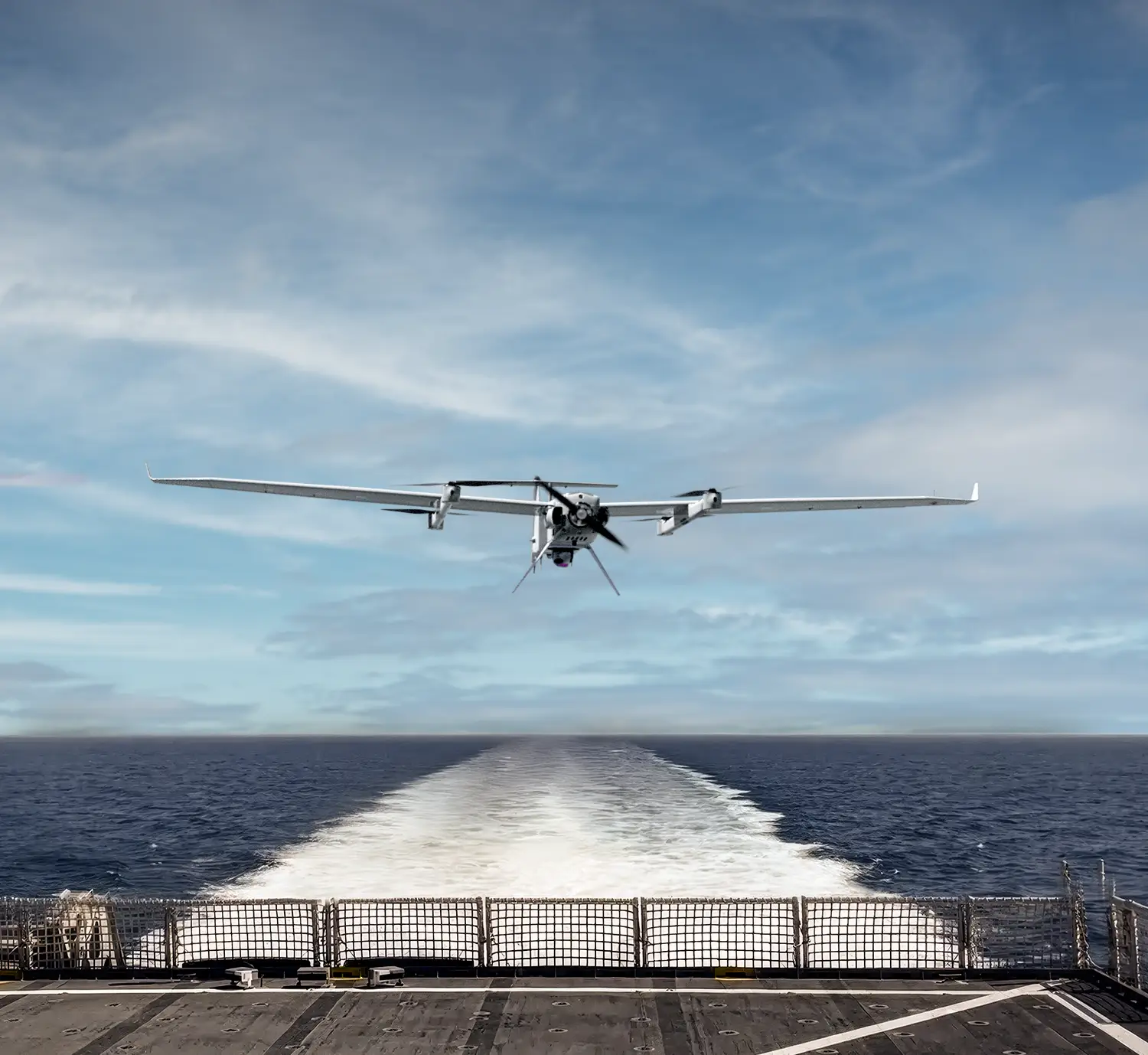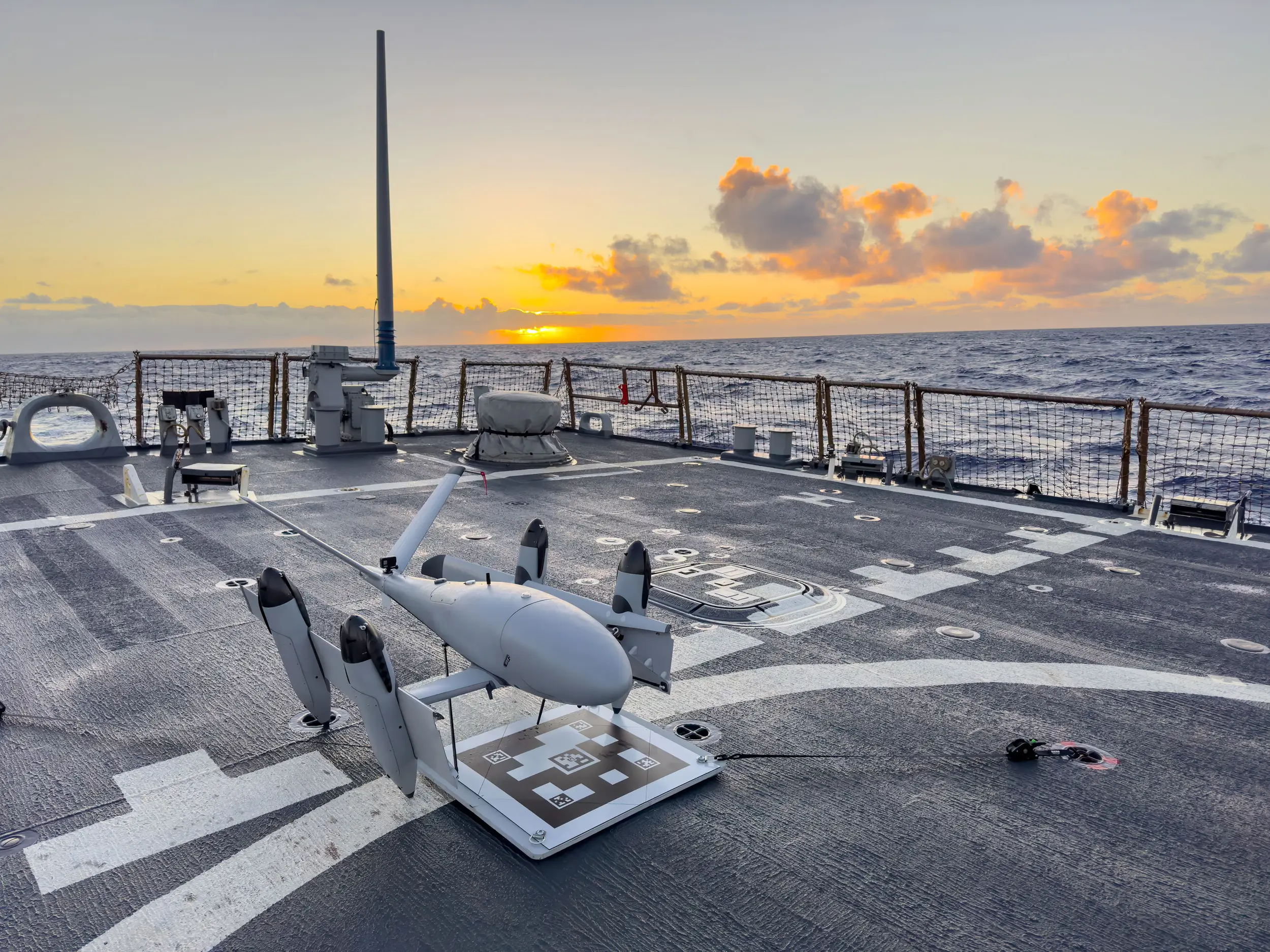
REPORT HOME > AUTONOMOUS ADVANTAGe
April 2025 | technology report | UAS
Traditionally the preserve of complex and expensive transport helicopters or vulnerable logistics trucks, getting essential equipment to the point of need on the front line may soon be revolutionised by deploying advanced uncrewed systems in this unsung but vital role.
Above: Elroy Air successfully conducted flight demonstrations of its Chapparal cargo UAS at Yuma Proving Ground under the MARV-EL Phase 1 effort. (Photo: Elroy Air)
VTOL UAS hold key advantages in the battlefield resupply mission, removing operators from harm’s way and providing cost efficiencies and other benefits. With a range of developers focused on the area, this report examines the future of autonomous resupply and the technological and operational challenges that must still be overcome.
The utilisation of UAS keeps more people further from danger, potentially saving lives, according to Matty Todhunter, Shephard’s senior UAS analyst. There are a range of other benefits, he added, including the fact that “crewed helicopters and their crews would be freed up to perform other duties”.
Numerous efforts are under way in this area among military organisations, Todhunter noted. For instance, he pointed to the Unmanned Logistics Systems – Air (ULS-A) effort being pursued by the US Marine Corps. According to Naval Air Systems Command (NAVAIR), this “supports a variety of tactical resupply mission requirements when risk to ground and manned air systems are deemed unacceptable due to austere operating environments and elevated ground threats”.
Similar efforts are happening in the US Army and Navy, Todhunter said, while the UK's Royal Navy is pursuing a UAS Heavy Lift Capability programme.
Against this backdrop, a wide range of companies are chasing innovation in the field. For example, Elroy Air is the developer of the Chaparral cargo UAS, which was demonstrated to the US Marine Corps (USMC) as part of the service’s Medium Aerial Resupply Vehicle – Expeditionary Logistics (MARV-EL) programme. In March 2025, the Japan Ground Self-Defense Force announced it would be testing Chaparral later this year for autonomous aerial logistics operations.
"Middle-mile cargo UAS systems are actively in development across the industry," Elroy Air CEO Andrew Clare told Shephard. "While these systems have not yet been deployed in battlefield resupply by an OEM, progress is advancing rapidly, with flight demonstrations, military partnerships and testing under way to pave the way for operational use."
The company successfully conducted flight demonstrations at Yuma Proving Ground under MARV-EL Phase 1, Clare said. It also has multiple Small Business Innovation Research (SBIR) contracts with the US Army and US Air Force, as well as other upcoming contract announcements.
Significant advantage
The backpack solution VTOL UAS offer significant advantages for battlefield resupply, said Clare, cutting acquisition and operating costs to roughly one-tenth that of helicopters while eliminating risks to human life.
They also reach critical locations in a fraction of the time required by ground convoys and deliver supplies almost anywhere, including in challenging ship-to-shore or island-to-island transfers, making them particularly effective for the types of scenario faced by US Indo-Pacific Command (INDOPACOM), with these being a major regional priority for the US military today.
Looking to the Indo-Pacific in particular, Clare highlighted a range of challenges to effective distributed logistics which could be resolved through use of UAS. This includes a lack of infrastructure, with numerous, sparsely inhabited islands that are located far from established US and allied bases. He also pointed to adversarial threats.
"In a contested environment, delivering supplies via high-value crewed transport vehicles (planes, helicopters, ships) is much riskier due to the potential for enemy attack or interference with supply routes. Solutions are needed to keep troops out of harm’s way, and robotic systems excel at jobs that are dull, dirty or dangerous."
UAS designs such as medium-lift, hybrid-electric autonomous VTOL drones can provide adaptability, supporting a resilient supply chain, he said, delivered by replaceable, low-signature assets.
Above: Schiebel is developing the Camcopter S-300, which will be able to fly for 24 hours with a payload capacity of 250kg. (Photo: Schiebel)
VTOL UAS specialist Schiebel has conducted a range of demonstrations in the battlefield resupply role with its Camcopter S-100 model, said Neil Hunter, the company’s head of global sales. This has included work with the US Navy, in which the company simulated a resupply mission in and out of a forest clearing, where blood and medical supplies were delivered.
Hunter said the system’s cargo box and underslung payload options make it suited for carrying urgently needed supplies. "Recently the S-100 was selected by the European Defence Agency for its cross-domain logistics programme," he added. "The large-scale initiative, hosted by the Italian Army, will focus on collaborative experimentation with UAS and unmanned ground systems (UGS)."
With their hovering capability and ability to launch and recover to and from confined areas, VTOL UAS can operate throughout the battlefield, noted Hunter, including close to the front line.
"Last-mile resupply is one of the most dangerous missions for manned assets (aerial or ground). With an unmanned system, essential goods, such as blood reserves, medication, ammunition and urgently needed spare parts can be transported without risking human lives."
Schiebel plans to expand its work in this area in the coming years. The payload capacity of the S-100 is 50kg and flight duration is typically six hours, with these being useful specifications for last-mile resupply, he noted. However, the company is developing the Camcopter S-300, which will be able to fly for 24 hours with a payload capacity of 250kg. "This will of course create many more possibilities for heavier cargo and resupply into remote and dangerous areas."
Nonetheless, there are challenges for such systems in the battlespace. For instance, Hunter pointed to the risk from jamming and cyberattacks, as well as active threats including electronic warfare and kinetic effectors. He said that Schiebel "gathered a lot of experience overcoming such scenarios" when the S-100 was used by the OSCE in Ukraine to monitor the ceasefire in the country prior to Russia’s full-scale invasion in 2022.
Autonomy is a crucial aspect of the advantages supplied by VTOL UAS in the battlespace. While a pilot will oversee S-100 operations from a ground control station – intervening in case of complications – the platform generally flies autonomously using waypoint navigation. It also automatically takes off and lands. ‘With the technological advances in the field of artificial intelligence (AI), it could be possible to solely rely on the UAS itself to conduct pre-defined missions and operations,’ Hunter added.
Independent operations
Autonomy is a crucial aspect of the advantages conferred by VTOL UAS in the battlespace. While a pilot will oversee S-100 operations from a ground control station – intervening in case of complications – the platform generally flies autonomously using waypoint navigation. It also automatically takes off and lands. "With the technological advances in the field of artificial intelligence (AI), it could be possible to solely rely on the UAS itself to conduct pre-defined missions and operations," Hunter added.
Autonomy in flight has become "table stakes" for UAS, added Clare, with the introduction of detect-and-avoid systems making beyond-visual-line-of-sight (BVLOS) flight feasible and safe for large and small systems. He said Chaparral uses autonomy in its cargo-handling operations, with the ability to autonomously locate a payload, navigate the vehicle to it, and grasp, lift and attach it to the aircraft pre-flight.
"At the destination, Chaparral drops off its payload and picks up a return payload without operator intervention," Clare noted. "This low-human-touch requirement reduces personnel needs and increases safety in the battlefield, given that people will not need to meet the aircraft at each cargo acquisition or delivery point."
Pennsylvania-based Near Earth Autonomy meanwhile provides autonomy technologies – including sensors, computing and software – for a range of VTOL UAS providers, among other applications. The company partnered with Kaman Air Vehicles on the latter's KARGO heavy-lift VTOL, which has competed for MARV-EL and has also been demonstrated for the US Army.
Other projects include work with PteroDynamics on delivering BVLOS capabilities and other navigation and flight control systems for its Transwing VTOL UAS. Additionally, Near Earth Autonomy has worked on larger-scale capabilities, including autonomous control of a helicopter.
Its CEO, Sanjiv Singh, said the company’s focus is on "push-button autonomy, meaning you push a button and it goes". This means a person technically does not need to be “in the loop”, with a focus instead of being “on the loop”: "The idea is that you can of course redirect it – you can cancel the mission, bring it back. But you don’t need communication to keep it safe."
Above: Near Earth Autonomy has partnered with Kaman Air Vehicles on the company’s KARGO heavy-lift VTOL. (Photo: Near Earth Autonomy)
Like self-driving cars, safety here should be built in automatically, he added. Systems also need to “fail safely”, he noted, with a default landing plan for emergencies, for instance.
There are several strong use cases for autonomous VTOL UAS in the resupply space, Singh said, also pointing to low-risk delivery of food, ammunition, blood and medical supplies. He further emphasised the ability to deliver fuel, a vital commodity in this environment. "If they [soldiers] are in isolated places, they won’t have access to much of the fuel they need to run their generators," he explained.
Jumping ahead
Veteran UAS developer AeroVironment’s JUMP 20-X VTOL is a multi-mission vehicle, noted Shane Hastings, the company’s vice president and general manager for medium UAS. While JUMP 20-X is not designed for specifically for logistics, the platform does offer around 14kg of payload carrying capability which could provide customers with the option to transport smaller loads.
This could have use cases in ground resupply, he noted, adding that AeroVironment is particularly interested in the maritime mission (see box, below): "If you've got to get a wrench from a destroyer to another vessel and you're using a helicopter to transit the part, that's an expensive mission. A small UAV can easily do the job."
Hastings pointed to the potential for technological advances to support the increased autonomy of VTOL UAS. For instance, he said that ISR missions generally run from “launch point A to landing point A”, with the drone completing its task then returning to the place where it originally took off or a known landing space, such as a different location on the same ship deck.
However, in logistics missions, it would need to go from "launch point A to landing point B", without full visibility of potential risks at its destination. A solution such as LIDAR sensors and recognition software would enhance autonomous landing visibility at the point of arrival, he said.
Above: While the Jump 20-X has not been designed for logistics, the platform does have 30 piunds of payload capability which could provide customers with the option to transport smaller items such as spare parts. (Photo: AeroVironment)
The rapid rise of AI is likely to transform the potential of VTOL UAS in resupply looking forward, experts agree. Clare said it will optimise flight routes for considerations like maximum fuel efficiency or minimum detection probability by adversaries, while it could also be deployed in the perception systems of the UAS.
"Finally, AI will help battlefield operations by supporting the coordination of multiple uncrewed assets - getting material to the point of need reliably while making optimal use of resources."
With autonomy advancing across the board, and recent conflicts highlighting the need to remove troops from imminent danger wherever possible, resupply by drone could rapidly become a standard procedure for those armies ready to embrace the technology.
Naval notions - the role of uncrewed resupply at sea
The naval sector also holds strong potential for VTOL UAS in the resupply mission. This is a major focus for PteroDynamics, developer of the Transwing family aircraft, which has worked with such companies as Near Earth Autonomy, Flighthouse and Applied Navigation.
PteroDynamics conducts a range of work in maritime cargo resupply, notably through its contract with the US Naval Air Warfare Center Aircraft Division (NAWCAD) to design, develop and demonstrate its autonomous P-5 Transwing VTOL UAS for the Blue Water Logistics (BWUAS) contract
This effort is focused on critical repair cargo, said John Sommerfield, marketing and communications strategist at PteroDynamics; it is an extension of the company’s existing work with NAWCAD, which focused on the smaller XP-4 platform. The XP-4 flew demonstration missions at the Rim of the Pacific (RIMPAC) exercise in 2024, Sommerfield noted, demonstrating ship-to-ship, shore-to-ship and ship-to-shore critical repair cargo resupply missions from the deck of the USS Curtis Wilbur.
The BWUAS contract is to design, develop and demonstrate P-5 systems that can carry up to 50 pounds (22kg) of critical repair and resupply cargo that Military Sealift Command would typically ship, said Sommerfield.
Above: The Transwing XP-4 flew demonstration missions during the Rim of the Pacific (RIMPAC) exercise in 2024. (Photo: PteroDynamics)
There are a range of challenges in delivering this critical repair cargo in contested environments, he added, including austere environmental conditions, such as wind, sea states, salt and weather. "UAS must have excellent VTOL capabilities to operate off heaving decks of ships that are under way at sea. The smaller XP-4 during RIMPAC operated in winds exceeding 20 knots during take-off and landing, with ship speeds up to and exceeding 20 knots.’
Another challenge includes navigating to and from specific vessels in contested GPS-denied environments: at sea, where there are no physical landmarks to guide visual navigation. To address this issue, the company is working with its partners to develop navigation and flight control solutions, including operating BVLOS.
Additionally, Sommerfield pointed to the challenge of operating in an electromagnetic environment where a ship’s radar or satellite communications equipment is generating electronic emissions.
"Electromagnetic interference and electromagnetic compatibility is an area of constant development in small UAS. PteroDynamics is taking the important lessons learned from operational manned aircraft in complex electromagnetic environments aboard US Navy ships. We will pragmatically implement those lessons to ensure our systems will operate effectively within the fleet environment," he said.
